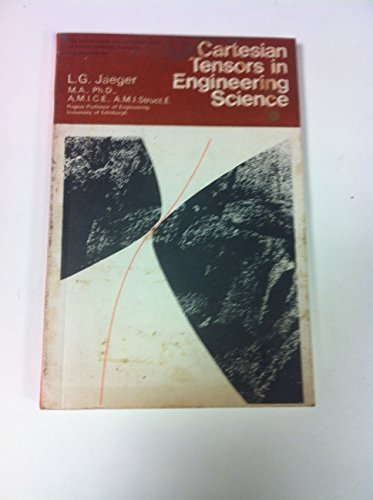Verwandte Artikel zu Cartesian Tensors in Engineering Science: The Commonwealth...
Cartesian Tensors in Engineering Science: The Commonwealth and International Library: Structures and Solid Body Mechanics Division - Softcover

Inhaltsangabe
Cartesian Tensors in Engineering Science provides a comprehensive discussion of Cartesian tensors. The engineer, when working in three dimensions, often comes across quantities which have nine components. Variation of the components in a given plane may be shown graphically by a familiar construction called Mohr's circle. For such quantities it is always possible to find three mutually perpendicular axes, called principal axes, with respect to which the six "paired up" components are all zero. Such quantities are called symmetric tensors of the second order. The student may at this stage be struck by the fact that the physical quantities with which he normally deals have either one component, three components or nine components, being respectively scalars, vectors, and what have just been called second order tensors. The family of quantities having 1, 3, 9, 27, . components does exist. It is the tensor family in three dimensions. The book discusses the "tests" a given quantity must pass in order to qualify as a member of the family. The products of tensors, elasticity, and second moment of area and moment of inertia are also covered. Although written primarily for engineers, it is hoped that students of various branches of physical science may find this book useful.
Die Inhaltsangabe kann sich auf eine andere Ausgabe dieses Titels beziehen.
Reseña del editor
Cartesian Tensors in Engineering Science provides a comprehensive discussion of Cartesian tensors. The engineer, when working in three dimensions, often comes across quantities which have nine components. Variation of the components in a given plane may be shown graphically by a familiar construction called Mohr's circle. For such quantities it is always possible to find three mutually perpendicular axes, called principal axes, with respect to which the six "paired up" components are all zero. Such quantities are called symmetric tensors of the second order. The student may at this stage be struck by the fact that the physical quantities with which he normally deals have either one component, three components or nine components, being respectively scalars, vectors, and what have just been called second order tensors. The family of quantities having 1, 3, 9, 27, . components does exist. It is the tensor family in three dimensions. The book discusses the "tests" a given quantity must pass in order to qualify as a member of the family. The products of tensors, elasticity, and second moment of area and moment of inertia are also covered. Although written primarily for engineers, it is hoped that students of various branches of physical science may find this book useful.
„Über diesen Titel“ kann sich auf eine andere Ausgabe dieses Titels beziehen.
EUR 6,96 für den Versand von Vereinigtes Königreich nach Deutschland
Versandziele, Kosten & DauerNeu kaufen
Diesen Artikel anzeigenEUR 11,59 für den Versand von Vereinigtes Königreich nach Deutschland
Versandziele, Kosten & DauerSuchergebnisse für Cartesian Tensors in Engineering Science: The Commonwealth...
Cartesian Tensors in Engineering Science.
Anbieter: Plurabelle Books Ltd, Cambridge, Vereinigtes Königreich
Paperback. Zustand: Very Good. Series: Commonwealth and International Library of Science, Technology, Engineering, and Liberal Studies. viii 116p paperback with white and brown cover, very good condition, binding firm, name to endpaper, pages clean and bright, all text and diagrams clear and sharp, a very good copy, first edition Language: English. Bestandsnummer des Verkäufers 242358
Anzahl: 1 verfügbar
Elementary Theory of Elastic Plates.
Anbieter: Plurabelle Books Ltd, Cambridge, Vereinigtes Königreich
Paperback. Zustand: Very Good. Series: Commonwealth and International Library of Science, Technology, Engineering, and Liberal Studies. ix 108p paperback with white and blue cover, very good condition, binding firm, spine a little rubbed, name to endpaper, pages clean and bright, all text and diagrams clear and sharp, a very good copy, first edition Language: English. Bestandsnummer des Verkäufers 242366
Anzahl: 1 verfügbar
Cartesian Tensors in Engineering Science
Anbieter: Revaluation Books, Exeter, Vereinigtes Königreich
Paperback. Zustand: Brand New. 124 pages. 7.75x5.00x0.28 inches. In Stock. Bestandsnummer des Verkäufers zk0080112218
Anzahl: 1 verfügbar

